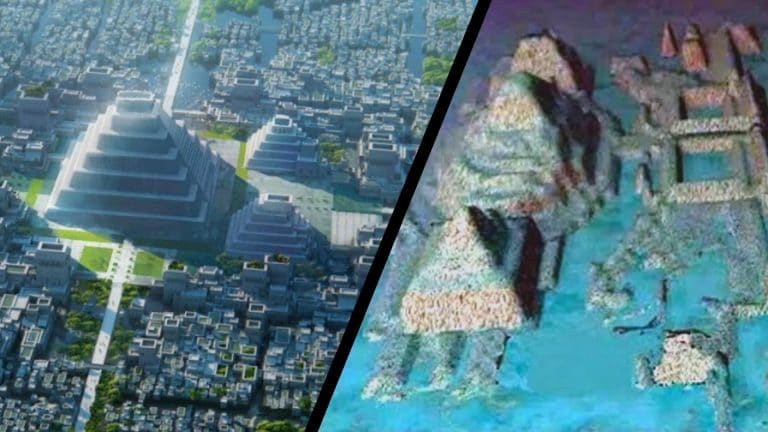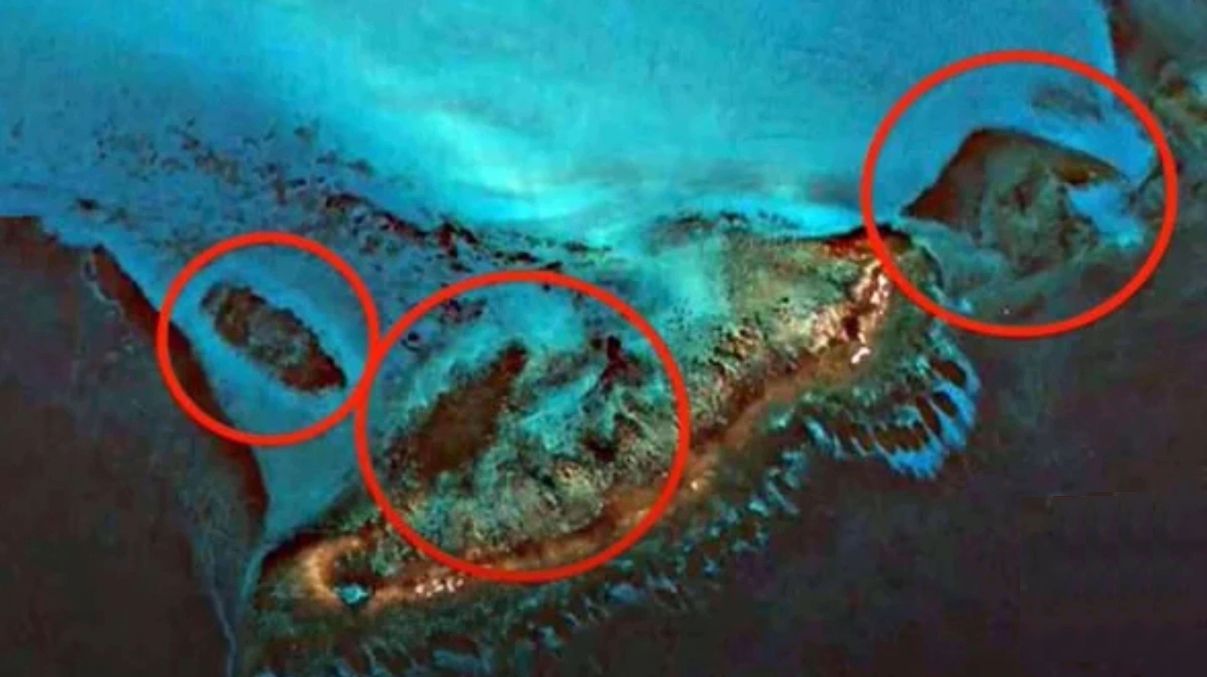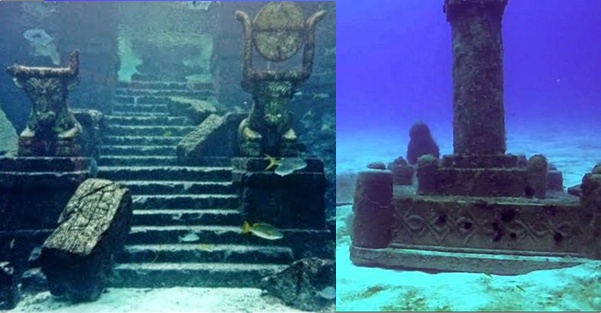It is said that space is the final frontier. Except, that’s not really true…
Consider, over 70% of the earth’s surface is covered by water, nearly all of it ocean. And yet, only 5% of the world’s oceans have been explored by human beings, the remaining 95% still a dark and uncharted frontier. What secrets might lie within this unexplored expanse? What could be down there, just waiting to be found?
Numerous ancient civilizations have provided us with at least one answer. Across eras and cultures separated by thousands of miles, there are stories of once-great cities suddenly sinking to the bottom of the ocean, lost forever.
For many years, these stories were regarded as little more than a myth. Until, in modern times, archaeologists began to discover ancient ruins submerged beneath the ocean all over the world, and the question started to get asked: could these ruins be evidence of the advanced prehistoric super cities spoken about by the ancients?
Or, maybe they are evidence of something more, something out of this world.
The Cuban Underwater City
“About 15 years ago, I heard about some American soldiers from a submarine going into a bar in Cuba and shooting off their mouths about an ancient underwater city they found off the coast of Cuba. They said it had hundreds of buildings and was incredibly intact. They also said they saw numerous pyramids in it. Today, I actually seem to have found part of it.”
These were the words of popular author and YouTuber Scott C. Waring in mid-2020. He was claiming that by using Google Earth to scour the ocean floor for anomalies, he had found multiple underwater pyramids off the coast of Cuba in the Caribbean Sea.
Incredible as this story was, Waring went further, alleging a coverup. He noted that while the anomalies appeared when examining the area in the web browser version of Google Earth, in the downloaded version, the entire area was blacked out. In his words, “that really makes me think Google hid it on purpose so that the city will remain hidden.”
If it was hidden on purpose, what purpose? If it was a coverup, then what was being covered up?
Predictably, Waring was called a conspiracy theorist, and his purported findings were largely rejected in the mainstream. Except, what he’d found had already been found before, and in fact, documented.
In 2001, the Cuban government launched a project to search for sunken ships left over from the Spanish colonial era in the waters off its shores. It is estimated that billions of dollars of gold bullion carried by these ships are still sitting on the ocean floor, part of what has been called “the richest galleon cemetery in the world.”
The project was led by Advanced Digital Communications, a Canadian company headed by marine biologist Pauline Zalitzki and her husband, Paul Weinzweig. Using the most advanced sonar equipment available, they scanned the ocean floor for irregularities, when suddenly, their equipment picked up something that stunned them.

There, an incredible 650 meters below the surface, were what appeared to be a series of symmetrical and geometric stone structures, standing out against the barren terrain of the ocean floor. In short order, they sent down a remotely operated vehicle equipped with a camera to explore further. What they found could not be denied. In the words of Zalitzki:
“It is stunning. What we see in our high-resolution sonar images are limitless, rolling, white sand plains, and, in the middle of this beautiful white sand, there are clear man-made large-size architectural designs. It looks like when you fly over an urban development in a plane, and you see highways, tunnels, and buildings.”
Weinzweig added:
“Some structures within the complex may be as long as 400 meters wide and as high as 40 meters. Some are sitting on top of each other. They show very distinct shapes and symmetrical designs of a non-natural kind. We’ve shown them to scientists in Cuba, the U.S., and elsewhere, and nobody has suggested they are natural.”
But how could this be possible? Many pointed out that to sink to that depth, the city would have to be over 50,000 years old, long before humans had the architectural capacity to construct what had been found.
Surely, this is the type of mystery that requires further investigation. Except, this is not what happened. Shortly after the discovery, the Cuban government unexpectedly cut the exploration project short, and stories of the find disappeared from mainstream media. In fact, the story had nearly faded from memory altogether until the proclamations of Waring in 2020.
Interestingly, this is not the first time the story of an underwater city off the coast of Cuba had appeared, then faded from memory. Back in 1954, Leicester Hemingway was flying from the United States to Cuba to visit his brother, the famed American writer Ernest Hemingway, when he noticed something peculiar out the plane window. As media reports recorded, submerged under the water below him was “an expanse of stone ruins, several acres in area and apparently white, as if they were marble.”
Strange that it would be Leicester Hemingway who reported this. It is well known that Ernest Hemingway spent a great deal of time not only in Cuba, but just over 100 miles away on the tiny island of Bimini. It was this setting from which Hemingway concocted his seminal works The Old Man and the Sea and Islands in the Stream.
The Bimini Road
In 1968, seven years after Hemingway’s death, a team led by subsea archaeologist Joseph Mason Valentine discovered a half-mile stretch of limestone blocks submerged in the ocean just off the coast of Bimini, like a paved road, too perfect to have been created naturally. The discovery came to be known as the ‘Bimini Road.’

But, a road to what?
Curiously, Ernest Hemingway was known to call Bimini “the end of the world.” Was he just being grandiose, euphemistic, as writers sometimes are? Or did he, and his brother, know something the rest of us didn’t?
For decades, questions about the Bimini Road remained unanswered, until, in 2009, a team led by archaeologist Jes Alexander mapped a grid of the ocean floor surrounding Bimini using a combination of Google Earth, satellite imagery, and ocean floor maps. As Alexander amazingly described, they discovered,
“…foundation ruins, rubble sections of building walls, and ruins of large public edifices. Some of what remains standing clearly show evidence of intelligent structure – post and lintel construction, parallel wall sections, and right angles – things that could not be explained as having been natural in origin.”
Just like off the shores of Cuba, it appeared they’d discovered the submerged ruins of an ancient city.
Could this really be true? Could deep below the ocean waves lie ancient cities from a prehistoric past? And if so, what could these forgotten cities tell us about human history?
The Legend of Atlantis
Nearly 2500 years ago, the legendary Greek philosopher Plato penned one of his most longstanding and most notorious works. It told the story of the lost continent of Atlantis.
According to Plato, Atlantis was an advanced island civilization which had existed many centuries before the ancient Greeks. Its continent was an island larger than Libya, and Asia Minor put together, located just beyond the Pillars of Hercules, meaning, beyond the Strait of Gibraltar, somewhere in the Atlantic Ocean. The fate of this mighty civilization is described by Plato in his dramatic conclusion to the story:
“There occurred violent earthquakes and floods; and in a single day and night of misfortune all your warlike men in a body sank into the earth, and the island of Atlantis in like manner disappeared in the depths of the sea.”
Despite its eloquence, this story may have been remembered as little more than another of Plato’s rhetorical tools, rather than a historical possibility, if not for the work of U.S. congressman Ignatius L. Donnelly. In 1882, Donnelly published The Antediluvian World, in which he hypothesized that Atlantis was not only real, but that it was the civilization that populated much of the ancient world. According to Donnelly, Atlantis inspired Greek, African, Indian, and Scandinavian myths, as well as those among the native tribes of the Americas. For his work, Donnelly is credited with starting the modern search for Atlantis.
In the 1930s, this search led American psychic Edgar Cayce to claim he knew where Atlantis was, and when it would be discovered. Stunningly in hindsight, he declared that Atlantis was near the small and then-unknown island of Bimini, and that it would be discovered in 1968 or 1969. Of course, 1968 was the year the Bimini Road was found. Could it be that this road is, in fact, the road to Atlantis? And were the ancient ruins found around Bimini in 2009 the borders of this ancient lost continent? Was this what Hemingway meant by “the end of the world?”
Perhaps, but perhaps not.
It seems that any time something unusual is found at the bottom of the ocean, claims of Atlantis appear. And the more that humans explore the earth’s uncharted waters, the more common these types of incredible discoveries become.
The Portuguese Underwater Pyramid
In 2013, an unassuming Portuguese fisherman named Diocleciano Silva was searching for fish between the islands of Sao Miguel and Terceira, some 900 miles west of the Portuguese capital of Lisbon in the middle of the Atlantic Ocean. As his sonar system scanned the water, it picked up something which shocked the humble fisherman.
There, below his boat, appeared to be a perfect pyramid, some 60 meters tall, sitting on the ocean floor. As Silva told Portuguese news outlets:
“It’s amazing because it forms a perfect pyramid. And moreover, orientation [and] deployment of the pyramid: the vertices are oriented north and south, just north and south, such as the Giza pyramids in Egypt,”
Incredibly, in the face of such a potentially significant discovery, the Portuguese navy rejected Silva’s claims and shut down all further investigation. However, they did not shut down the imagination of those who had heard the story, mainly when the Admiral in charge of the area gave a rare interview in which he proclaimed that even the navy did not have enough information about the structure to say definitively what it was.
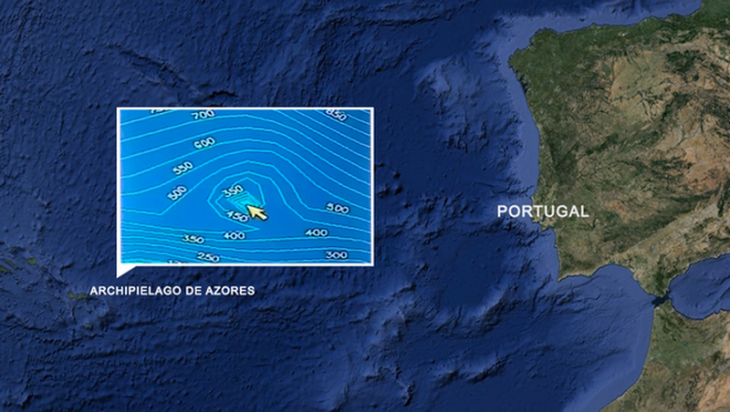
Certainly, many headlines blared, this must be part of the lost city of Atlantis.
Underwater Structure Off Baja California Coast
Then, in 2016, a new and even more bizarre underwater discovery captured attention. Some 45 miles off the coast of Mexico in the Bay of California, it seemed that Google Earth revealed a massive expanse of linear lines and massive outlines, reminiscent of the mysterious Nazca Lines in Peru.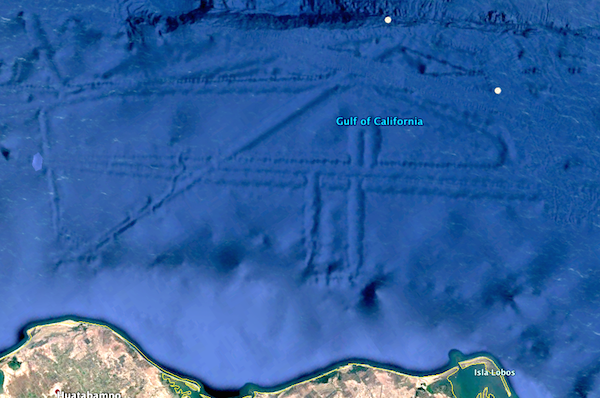
Some asserted that the lines designated an enormous underwater pyramid, many miles across. One of those was Scott C. Waring, who ruminated, “An 8.5-mile pyramid … biggest the world has ever known, and it’s right off Mexico.” Others asserted that the structure “cannot be a natural formation,” while Waring himself proclaimed there was a “100% chance” of it being “an intelligently made structure.”
Again, the headlines announced, we must surely have found Atlantis.
Ancient Settlement in Antarctica
In late-2016, NASA’s Operation IceBridge used remote sensing photography to create a three-dimensional view of what was under the mile-thick sheet of ice that covers the Arctic and Antarctic continents. Remarkably, the 3D constructions of Antarctica appeared to show the remains of settlement under the ice, unknown landmasses, and mysterious structures, some as big as the Eifel Tower.
Could this be the lost city of Atlantis, not sunk to the bottom of the ocean, but encased in ice?
Obviously, mysterious ruins hidden in the ice of Antarctica, or submerged in the water around Cuba, Bimini, Mexico, and Portugal, cannot all be Atlantis. But that’s just the point. If not Atlantis, then what are they?
Well, to start, Atlantis is not the only ancient tale of a submerged city lost to the dark depths of the ocean.
The Lost Continent of Mu
Augustus Le Plongeon had devoted his life to investigating the ancient Mayan culture in the Yucatan Peninsula of what is now Mexico. In the early-1880s, the archaeologist reached the pinnacle of his work. He had come across a series of ancient inscriptions which he purported to translate. According to Le Plongeon, they described an ancient lost continent called Mu, which had existed somewhere in the Pacific Ocean in prehistoric times, before being submerged in the ocean.Had he discovered the record of another Atlantis?
Many questioned the translations of Le Plongeon and thus the veracity of his claims, writing them off as the work of fiction. And there the story might have died, if not for a man named James Churchward.
In the 1930s, Churchward came forward with a story from his time as a British soldier in India. There, he asserted, he had befriended a high-ranking Indian priest who introduced him to a set of ancient clay tablets. They were written in a lost language that only a few people in the world could understand.
Consequently, Churchward set about convincing the priest to teach him the language, so that he might read the sacred tablets for himself.
After some time, he was able to read them, and to his amazement, they told an astounding tale. According to Churchward, they spoke of an ancient lost continent in the Pacific Ocean which had existed some 50,000 years ago. It was named Mu. Stretching some 3000 miles from north to south and 5000 miles from east to west, the vast continent was purportedly home to 64 million people, before suddenly sinking to the bottom of the ocean and disappearing.
Like Le Plongeon, Churchward’s claims were met with skepticism. Surely there could not be some sort of lost civilization at the bottom of the Pacific Ocean.
Or could there?
Yonaguni – Japan Underwater City
One day in 1986, a Japanese diver named Kihachiro Aratake was enjoying his favorite pastime, exploring the seafloor off the coast of Japan. On this particular day, Aratake was diving around Yonaguni Island, some 60 miles east of Taiwan, when he came across something he couldn’t believe. There beneath him were what appeared to be the ruins of a sunken city. There were castles, roads, monuments, a pyramid, even a stadium.
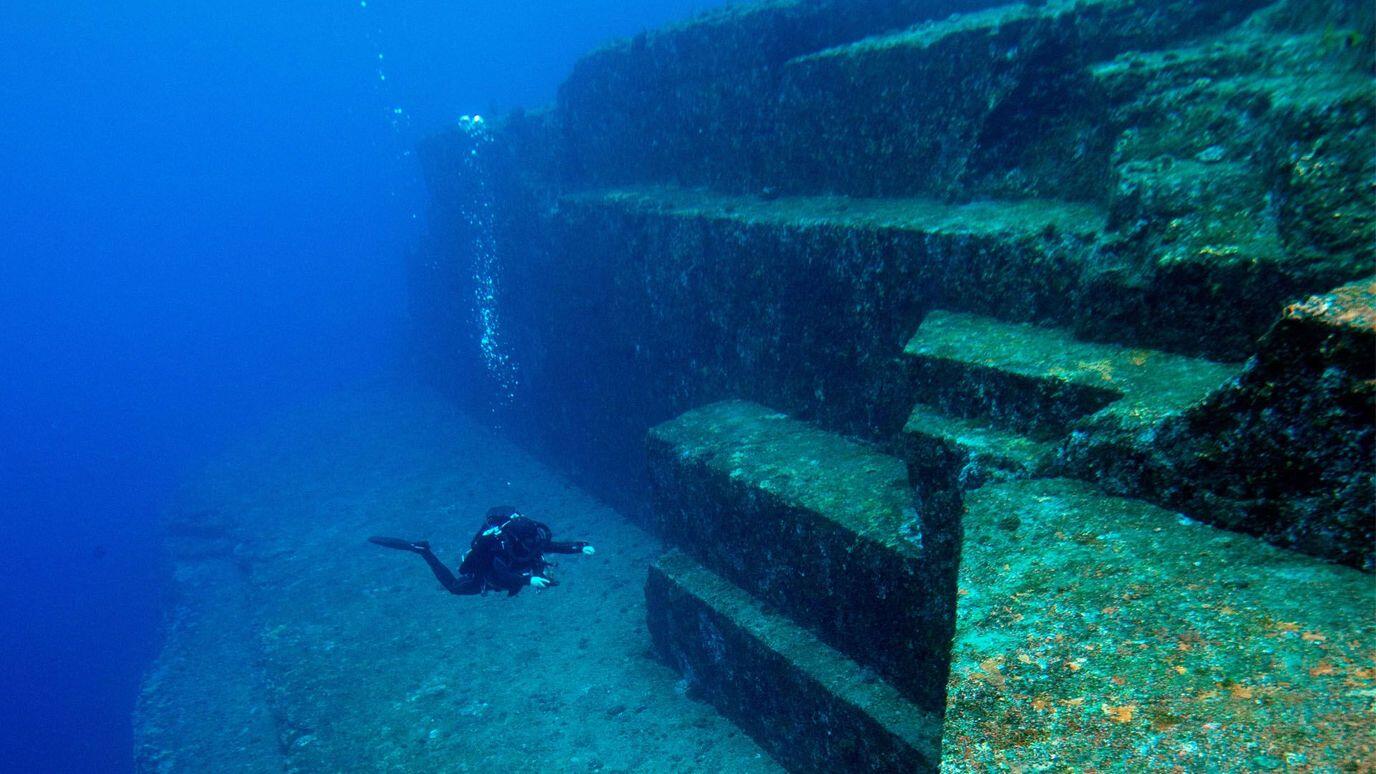
Immediately, a group of scientists led by Masaaki Kimura rushed to the area to investigate. In the years that followed, Kimura identified numerous structures at the Yonaguni site, and, amazingly, additional structures some 300 miles further into the ocean around the island of Okinawa. At both sites, he and his team noted walls constructed at right angles, hexagonal columns, even an underwater road, all displaying an unbelievable symmetry.
Some expressed skepticism that perhaps what Kimura was finding were not ruins, but actually just natural formations until his team began to uncover carvings of animals and people, even a face that seemed eerily similar to the Moai heads of Easter Island. Kimura exclaimed:
“I think it’s very difficult to explain away their origin as being purely natural, because of the vast amount of evidence of man’s influence on the structures,”
Could this really be the outskirts of a lost continent called Mu? More importantly, if ancient stories of Mu and Atlantis were true, how would this change our understanding of human history?
The Mythical City of Dwarka
In 1963, an investigation launched by the Indian government’s Department of Archaeology discovered what appeared to be the remnants of a sunken city in the Bay of Cambay off India’s Saurashtra Coast. Exploration in the murky waters was difficult, but by the late-1970s, the Marine Archaeological Unit of India had started underwater excavations, bringing up bits and pieces of pottery, jewelry, and other artifacts dated at over 3500 years old.
As time flew and technology advanced, so too did the exploration become more robust. Until, in 2002, India’s National Institute of Ocean Technology discovered a series of structures further out into the Bay, some 40 meters below the surface. Archaeologists descended, discovering sections of walls and buildings, sculptures, even human bones and teeth, the ruins of a vast city many miles long. Most incredibly, the artifacts were dated at nearly 10,000 years old, predating the ancient Egyptians by thousands of years.
To many familiar with ancient Indian tradition, the meaning of this discovery was obvious. It meant that the ancient stories of Lord Krishna were true.
According to the Mahabharata, a fundamental epic in Indian tradition, as well as many other ancient texts, Krishna fled the Indian continent to escape a never-ending cycle of war between his people and their neighbors. With the help of the god Vishwakarma, Krishna founded the island city of Dwarka. There, an advanced civilization lived amongst 700,000 palaces made of gold, silver, and precious stones, incredible structures which, as written in the Harivansha, “almost touched the sky” and “could be seen everywhere like clouds.”
According to the ancient texts, after Krishna’s death, the city and its advanced civilization sank into the ocean.
There are many who believe that the modern discovery of an ancient underwater city confirms the stories of Krishna are not myth, but historical records. If this is true, then what would it mean for our understanding of humanity’s past? As the BBC suggested,
“The remains of what has been described as a huge lost city may force historians and archaeologists to radically reconsider their view of ancient human history.”
But how?
Stories of Advanced Ancient Civilization
It’s not just that a 10,000-year-old Indian civilization would throw our understanding of where civilization started in disarray. It goes much deeper than that. Consider, if the ancient texts are telling the truth about Krishna’s mystical city of Dwarka, what else might they be telling the truth about?
Look back through the story of Krishna, to his time of conflict prior to founding Dwarka. There, a battle against a leader named Shalva is particularly notable. According to the texts, Shalva attacked Krishna in some sort of flying machine, unleashing what appears to be an energy weapon, projectiles described as bolts of lightning. In response, Krishna responds with a weapon “bright as the sun in the sky,” killing Shalva and wiping out his army in one fell swoop.
Here, the ancient Indian texts read like the pages of science fiction. Shalva – armed with a UFO that shoots lasers, and Krishna – with some sort of ancient nuclear weapon. But if the story of Dwarka is true, could this be as well? And if so, how would the ancients have come to be in possession of this type of advanced technology and weaponry?
There are some who suggest the answer is contained within the records of ancient cultures all over the world. Consider, from the Sumerians and Egyptians, to the native tribes the Americas, to the ancient civilizations of India, Asia, and beyond, all told stories of gods coming from the sky and bringing humans advanced technology and knowledge.
Many believe these beings were not gods at all, but ancient aliens, and that the ancient myths were actually a historical record of early extraterrestrial visitors to earth, those who fundamentally shaped human evolution.
Note that according to Sumerian texts, these visitors, called the Anunnaki, came to earth and interbred with primitive humans, founding the modern human race. It is interesting then that Plato described the inhabitants of the lost continent of Atlantis as “half-god and half-human,” while James Churchward asserted that sacred Indian tablets named the continent of Mu as “the place where man first appeared.”
Is it possible that stories of Atlantis and Mu and Krishna are not myths but historical records? And is it possible that these records tell of an ancient collaboration between human beings and alien visitors? Might this be why underwater discoveries are so often suppressed by official sources?
Maybe this is what awaits us at the bottom of the deep, dark, unexplored oceans. Not only the ruins of a lost human history, but an entirely different human history altogether.

